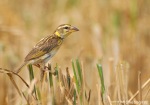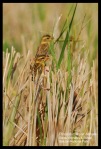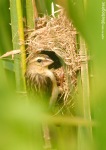Another large Old World family of finch-like birds, with 116 species, the weavers have a similar global distribution to the grassfinches (Estrildidae), except that Africa boasts the vast majority of species, with only a handful having reached tropical Asia, and none having crossed Wallace’s Line. Generally larger and more robust than the grassfinches, weavers are strongly sexually dimorphic during the breeding season, when males of most species sport bright red or yellow patches in their plumage or very large tails (widowbirds) with which to attract duller-plumaged females. Weavers can be divided into two groups based on their ecology and social organization. Savanna and grassland-inhabiting species are typically seed-eaters that are colonial and polygynous. In contrast, forest weavers are mainly insectivorous, solitary and monogamous. The Asian weavers fit into the first group.
As their name implies, these birds use their amazing weaving skills to construct large nests that are both a work of art and engineering. Generally, males build the framework of a nest using grass or palm leaves, and display above it to attract females. Some observation in Baluran show female construct both foundation and completing the nest building. If she is satisfied with his work, she mates with him, finishes building the nest, lays eggs and starts incubating them. Meanwhile the male builds another nest to attract a second female. Successful males have two or even three females, and defend the nest area from intruder males. Java hosts all three species of weavers that occur in Indonesia; Baluran has two of them.
- Manyar Jambul | Streaked Weaver | Ploceus manyar
- Manyar Jambul | Streaked Weaver | Ploceus manyar
- Manyar Jambul | Streaked Weaver | Ploceus manyar
- Manyar Jambul | Streaked Weaver | Ploceus manyar
- Manyar Tempua \ Baya Weaver | Ploceus philippinus
- Manyar Emas | Asian Golden Weaver | Ploceus hypoxanthus
- Manyar Emas | Asian Golden Weaver | Ploceus hypoxanthus
- Manyar Emas | Asian Golden Weaver | Ploceus hypoxanthus
- Manyar Emas | Asian Golden Weaver | Ploceus hypoxanthus
- Manyar Emas | Asian Golden Weaver | Ploceus hypoxanthus
- Manyar Emas | Asian Golden Weaver | Ploceus hypoxanthus
- Manyar Emas | Asian Golden Weaver | Ploceus hypoxanthus
- Manyar Emas | Asian Golden Weaver | Ploceus hypoxanthus
- Manyar Emas | Asian Golden Weaver | Ploceus hypoxanthus
- Manyar Emas | Asian Golden Weaver | Ploceus hypoxanthus















semoga populasi si manyar ini tetap terjaga dan langgeng…
coz, akhir2 ini, di pasar burung, rata2 setiap stan mempunyai burung ini, jumlahnya sampe ratusan per-kandang….
**very bad news T..T
menyedihkan…. :((
setuju gan smoga saja